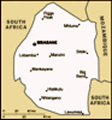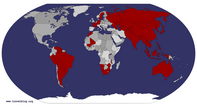Advertisement
Published: December 20th 2007
Swaziland was nothing like I expected. I had bought a brand new travel guide and read about Alpine peaks, cheese, chocolate, Heidi, and a national obsession with local hero Roger Federer. Nothing of the sort - the chocolate tastes of cardboard the cheese of plastic. Swaziland is a tiny, under-developed kingdom mostly surrounded by South Africa like a nut in a spanner, with Mozambique sharing a small border on the other side. It was held as a British colony long after we handed South Africa it's independence. It was then afforded its own independence in 1968 and is now one of the only absolute monarchist states in the world. In Swazi tradition the king rules alongside his mother. The current king being King Mswati III. The Swazi's openly idolise their King, even though it seems to be an undemocratic authoritative regime that spends fortunes on their own lavish lifestyle whilst governing a very poor nation. But I should be careful not to criticize too much. For a brief while I contemplated applying for citizenship. If I declared my love for the king and country to the embassy, alongside a small financial incentive, it would have definitely been possible to fast-track myself
a Swazi passport, which would have then solved all my African travel issues in one foul sweep. There are still strong connections with us Brits. Most notable are the police who still drive around in old-style Panda cars and wear the exact same uniform as seen in the original opening credits of The Bill - you know, the one where the two cops are walking side by side towards the camera.
Swaziland is close in terms of location and culture to Zululand, including a similar language structure. Like Zulu and other Bantu-derived languages, Seswati is click-based which is a strange and intriguing language to listen to. The clicks are usually mid-word and either made by the tongue against the teeth or roof of the mouth. It's impossible to express such languages in writing. So here goes -
The word "backpack" in Zulu is Unxazisuka, pronounced: "Un-CLICK AGAINST SIDE OF MOUTH-zee-su-gaa". Now you try.
If anything, the Swazi people are even more friendly and smiley than the Zulus - which is incredible given the scourge of AIDS in the country. They estimate anywhere between 40%-60% of the population of Swaziland is HIV+.
My time in Swaziland was mainly spent
hiking in mountains, haggling in markets and trying to spot big game in nature reserves. Along with no short amount of cycling up and down the valleys of the diminutive kingdom. The main valley links the biggest city, Manzini, with the capital Mbabane. There's not too much to say about Mbabane itself. Other than to say it's overlooked by the second biggest rock in the world. Sibebe rocks' monolithic proportions are second only to those of Ayers Rock. But the world doesn't have too much affection towards seconds. Sibebe rock is your Buzz Aldrin, your Camilla Parker Bowles, your Matrix Reloaded.
From Swaziland I crossed back into South Africa over a remote mountain pass border crossing. Then I free-wheeled all the way down to Barberton, an old mining town in the lowveld. There were no hostels of note here as it's off the tourist trail, just a couple of guesthouses. The one I was drawn to was called "Cockney Liz". I just had to ask what the name was all about. Cockney Liz was an east Laandon gal (think Peggy Mitchell) who came to Barberton with the gold rush. She ran a pub for the thirsty and newly wealthy
gold miners. The pub may or may not have been called the Queen Vic, I have no idea. At the end of each evening, after the lads had put back a few jars, she would auction herself off for the night (I was assured she was NOT a prostitute though). She became mega rich and a local legend. I was not planning on staying the night in Barberton but I neither had the energy to reach Nelspruit that night, nor the money to afford a guesthouse. So I asked if I could pitch a tent up in Cockney Liz's back yard. They said they'd rather I didn't, but asked my how much I'd like to pay for a 400 Rand room. I said I'd ideally not pay more than 150 Rand. Fine, they said. I was given a plush room, wined and dined. The next morning when I asked for my bill it had a zero invoice. Some people are far too nice.
Early that morning I completed the cycle to Nelspruit, the largest town near the Kruger Park. Here they have the usual hostels. The one I picked had a open-walled dormitory. The second day I was there
I returned back to much commotion. A Black Mamba had been found under my bed during the day (I'm talking a real-life 2 metre long highly neurotoxic snake, not any artificial electronic device). I think my reaction was supposed to be one of relief that I was out at the time, but being a bit of a snakophile I was actually disappointed not to have seen it - or try to catch it with my newly learned snake handling techniques.
From Nelspruit I hired a car for 3 days to explore Blyde River Canyon and Kruger Park. The canyon is disputedly the third deepest in the world, but it's the same old argument as to what constitutes a canyon. To be honest, I was just happy to enjoy the scenery and views along the upper rim and let the canyonists debate the technicalities. Then into Kruger Park. I had opted for the cheapo option of a self-drive instead of going with a tour party and professional guide. The main advantage of having a guide is his remarkable spotting abilities. But I'm actually quite a good animal spotter if I do say so myself, even with all the long grass
and shrubbery around the roadsides. Those years of searching for wayward golf balls in the rough have finally come to good use. Despite these self-proclaimed spotting abilities, I'm yet to bag myself that elusive leopard. All the other boxes are ticked and banked.
In between Nelspruit and Pretoria, I stopped off in Witbank where we have some (more) family friends. Here I stayed and recouperated (washed, laundered, hair cut, etc) for a few days. I was taken on a tour to the nearby Cullinan Diamond Mine. Southern Africa is the heartland of the diamond mining industry. The most productive places to mine diamonds are in volcanic pipes that reach far down to the earth's magma where diamonds are formed under enormous heat and pressures. The solidified volcanic rock is excavated from the pipes leaving massive open chutes in the ground. These are referred to as Big Holes and are scattered around southern Africa like a giant golf course. The most famous Big Hole is in Kimberley, but the Cullinan hole is the largest, with dimensions of 1,000m by 500m by 800m deep ("m" = metres, not miles, just in case you wondered). Even the most waywardest of golfers shouldn't
be too daunted standing on the tee for that hole. The largest gem-quality diamond ever found was in Cullinan mine in 1902. The Cullinan Diamond weighed in at over 3,000 carats. From it the Star of Africa and the Lesser Star of Africa were cut and polished. The value of these stones is unimagineable and the country could have auctioned them off for mind-blowing profits. Instead they gave them to the crown of England as a present. How nice of them. They now form part of the crown jewels and are on display in the Tower of London.
I arrived in Pretoria, the administrative capital of South Africa, mainly with the intention of trying to fast-track a new passport. This turned out to be very simple and the forms were completed within an hour or so of arriving in the city, giving me plenty of time to explore the rest of Pretoria. After taking dozens of photos of historic buildings for the sake of it I visited Freedom Park - a multi-cultural centre symbolising South Africa's struggle towards peace and democracy. Although not yet formally open to the public, I just happened to turn up when the journalists were being given a sneak preview and was invited to tag along. It also gave the journos the opportunity to include photos of a genuine tourist in their snaps.
That evening the final of the Telkom Knockout, South Africa's equivalent of the FA Cup final, was taking place in Pretoria's Loftus Stadium. This was a pitching wedge away from my hostel so I decided I would take a look and see if I could get my hands on a ticket. Although officially a sell out, with a little persuasion and a little more cash the touts are always happy to oblige and before long I had scooped up a ticket. The final was between Mamelodi Sundowns and the Kaizer Chiefs (yes, the band is named after them. The band are Leeds Utd fans and their favourite player, Lucas Radebe, started out at Kaizer Chiefs). Football in South Africa is very much the sport of the black population. Other than myself literally the entire crowd was full of brown faces. I felt like a Rice Crispie in a bowl of Coco Pops. Contrary to what I had been warned I found no hostility or intimidation around me, just warmth and a genuine interest in English football. The game itself was a 0-0 bore-draw, with Kaizer Chiefs winning on penalties. The most interesting part was the national anthem at the beginning. The South African national anthem has 4 verses, each in a different language (Zulu/Xhosa, Sesotho, Afrikaans and then English). It is an uplifiting and inspiring tune, much like most other national anthems. Meanwhile the British get to drone on about saving the Queen (or even just the English by the time the Welsh have sung Land of My Fathers and the Scots sung Flower of Scotland). No wonder our sports teams seem so unpassionate. No disrespect to the Queen, I hope God does save her, but come on, its not exactly getting my juices flowing.
And so I mounted my saddle one last time for the 80 km push from Pretoria to Johannesburg, where I fully intended on abandoning the bike and picking up something with a little more engine.
Advertisement
Tot: 0.146s; Tpl: 0.012s; cc: 12; qc: 64; dbt: 0.0823s; 1; m:domysql w:travelblog (10.17.0.13); sld: 1;
; mem: 1.2mb











Your king
non-member comment
Swaziland
Did you manage to do any skiing in swaziland? I hear the snow is amazing this year...